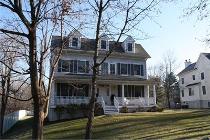
No sump pump would help with the water overflowing the banks of the Croton River in Croton on Hudson in Westchester County
Sump pumps: The first line of defense against flooding and mold contamination
If you live in a low lying area in a flood plain and there are torrential rains day after day, there isn’t much of anything that you can do to prevent your home from the destruction of flooding. Last weekend I visited friends in upstate New York’s Delaware County. Seeing mud covered belongings sitting out on the curb was heartbreaking.
For most of us however, flooding is not a function of rising streams but of rising water tables. When it pours and the water table rises, a sump pump may be your best friend. While sump pumps are a signal to prospective buyers that the water table can be high, not having a pump when you need one can be extraordinarily costly in terms of the destruction of your property and the compromise of your health caused by mold growth on damp surfaces.
What’s a sump pump? Typically it’s an electric pump that removes water that has collected in a below grade pit found usually in the basement of a home. The water flows into the pit either from rain saturated grounds or when the water table in that location rises above the basement floor level. If your home’s basement floods frequently, a sump pump can be a relatively simple cost-effective solution. These pumps send water away from a house to any place where it is no longer problematic.
Usually hardwired into a home’s electrical system, ideally sump pumps should also have a battery backup. If you live in an area in which the main power is out for prolonged periods of time, not unusual in Westchester County, a backup system is important because the sump pit can fill and overflow if the water is not constantly removed. Some sump pumps don’t use electricity at all; instead they use the home’s pressurized water supply, eliminating the need for a backup system. Typically installation involves making a hole in the concrete flooring of your basement, installing the pump and wiring it to your electrical system. You’ll want to discuss your options with the contractor who installs your pump system.
As with any home system or appliance, these pumps usually need some type of cleaning and general maintenance on a regular schedule, mostly just cleaning it out. The pump can get clogged with gravel, dirt, sand, and other debris carried in by the water which causes it to fail.
Pumps themselves are typically one of two types, submersible and above grade pedestal. The pedestal pump’s motor is mounted above the pit, where it is more easily serviced but also more conspicuous. The submersible pump is entirely mounted inside the pit, and is specially sealed to prevent its shorting out.
Incidentally one can get a rider to ones insurance policy that will cover flooding to your home if you have a sump pump and it fails. Be sure to check with your insurance agent on adding that to your home owners’ policy and verify exactly what damage is covered and where.



